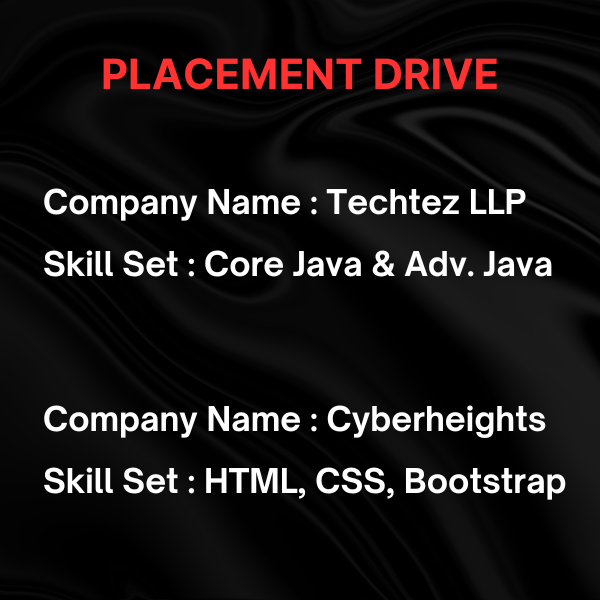×
Course Categories
×
Product Categories
Best HTML Interview Questions
Interview Preparation & FAQ for fresher’s to 5 years experienced
5.0
5.0
4.6
HTML Interview Questions HTML FAQ
Hi, Welcome to Monopoly IT Solutions, our Interview Questions / FAQs can be very helpful for interview preparation in several ways:
- Understanding the way how Questions are asked by interviewer
- Practicing Answers, find our appropriate ways of answeringand excel the interview
- Gaining Insight into the industry standard
- Reducing Anxiety of Interview
- Self analysis of Key Skills
Following are the conceptual theory questions
- HTML, or Hyper Text Markup Language, is the standard markup language for creating web pages. HTML lists are elements that organize and structure related information on a web page in an ordered or unordered way.
- The Main element. The < main> HTML element represents the dominant content of the < body> of a document. The main content area consists of content that is directly related to or expands upon the central topic of a document, or the central functionality of an application.
- HTML stands for Hyper Text markup language, and HTML5 is the 5th version of it. A lot of dynamic parameters were missing in the HTML for which we have to depend on third-party libraries, however, in the latest version of HTML it has become a lot easier for building a dynamic website. There are other features as well that have helped the developers attain more flexibility. As per the trends, 90% of the websites are already using HTML 5 and the latest versions of numerous browsers such as Google Chrome, Safar, Firefox, and more have already established support for HTML5.
- HTML entities, also known as character references, are reserved characters that have special meanings when used in HTML documents. They are often used to display characters that have special meanings in HTML, such as tags or attribute values. They can also be used to include symbols or characters from different languages that are not available on a standard keyboard. Ex:< ; & gt,
- HTML has many formatting tags that can be used to change the style and format of text. These tags can help improve the look and feel of web pages. Some examples of formatting tags include:
- Bold : or Makes text bold
- Italic : or Makes text italic and emphasized
- Small : < small> Sets a smaller font size
- Big : < big> Sets a larger font size
- Superscript : Formats text as superscript
- Subscript : Creates subscript text
- Underline : Underlines text
- Strikethrough : < del> or < s> Strikes through text to indicate deletion
- Insert : < ins> Highlights added or inserted text
- Semantic elements in HTML are elements that clearly describe their meaning to both the browser and the developer. They use words to represent what the element contains in human language. Semantic elements help users navigate and interact with a site, and make the code easier for developers to write and understand. In HTML there are some semantic elements that can be used to define different parts of a web page: < article> < aside> < details> < fig caption> < figure> < footer> < header> < main> < mark> < nav> < section> < summary>
- We separate a section of texts in HTML using the below tags:
- < br> tag – It is used to separate the line of text. It breaks the current line and shifts the flow of the text to a new line.
- < p> tag – This tag is used to write a paragraph of text.
- The rel attribute is used to describe the relation between the current document and the linked document and the target attribute is used to specify the target link. Here, target=”_blank” is used to open a hyperlink in a new tab.
- Scalable Vector Graphics (SVG) are vector-based graphics used to define graphics for the web. They are a good choice because they are small in file size and highly scalable, so they don't pixelate when zoomed into embed an SVG via an < img> element, you just need to reference it in the src attribute as you'd expect. You will need a height or a width attribute. If you have not already done so, please read Images in HTML.
- In HTML tables, cellpadding refers to the space between the cell's border and its content, while cell spacing refers to the space between adjacent cells.
- Yes ,we can display a web page inside another HTML web page.HTML provides a tad < iframe> using which we can achieve this functionality. < iframe src="url of the web page to embed">
- HTML elements which do not have closing tags or do not need to closed are void elements EX:< br>, < hr>, < img>
- < header> : stores the starting information about the page
- < footer> : represents last section of the page.
- < nav> : The navigation menu of the html page.
- < article> : it is a set of information.
- < section> : it is used inside block to define the basic structure of a web page.
- < aside> : sidebar content of the page.
- The anchor tag is used to create a hyperlink to another webpage or to a certain part of the webpage and these links are clickable.
- The link tag < link> defines a document and an external resources and these are not clickable.
- Html provides a < sript> tag using which we can run the JavaScript code and make our html page more dynamic.
- The < figure> tag specifies the self-contained content like diagrams ,images ,code snippets ,etc. < figure> tag is used to semantically organize the contents of an image like image ,image caption etc
- The < img> tag is used to embed the picture in the HTML5 document.
- No, The < data list> tag and < select> tag are different. In the case of < select> tag a user will have to choose from a list of options, whereas < data list> when used along with the < input> tag provides a suggestion that the user selects one of the options given or can enter some entirely different value.
- Yes, in HTML5 We can drag and drop an element. This can be achieved using the drag and drop-related events to be used with the element which we want to drag and drop.
- HTML5 supports the following three types of audio file format: 1. Mp3
2. WAV
3. OGG
- There are two types of web storage that are used to store data locally in HTML5:
- Local Storage : This helps in storing data that will be retained even though the user reopens the browser. It is stored for each webapp on different browsers
- Session Storage : This is used for one session only .After the user closes the browser this gets deleted.
- HTML 5 provides two tags:< audio> and < video> tags using which we can add the audio or video directly in the webpage.
- HTML supports two kinds of Graphics:
- .Canvas :It is like drawing on a whitepaper or a blank web page. We can add different graphics designs on web pages with available methods for drawing various geometrical shapes.
- .SVG :Scalable Vector Graphics are used mostly for diagrams. It follows the XML format.
- Date
- Week
- Month
- Time
- Color
- Search
- Placeholder
- Range
- URL
- There are three types of web workers:
- Dedicated Workers :These are workers that are utilized by a single unit.
- Shared Workers :These are workers that are utilized by multiple scripts running in different windows.
- Service Workers :These act as proxy servers between web applications ,the browser and the network.
- A Block-level elements always starts on a new line and the browser automatically add some space before and after element. Ex:< div>,< p>
- Inline element does not start on a new line. An inline element only takes up as much as necessary.
Following are the coding based questions





